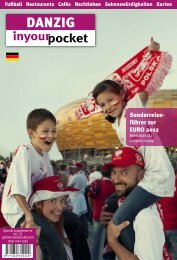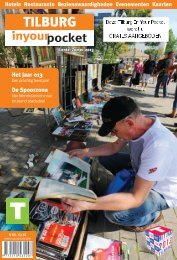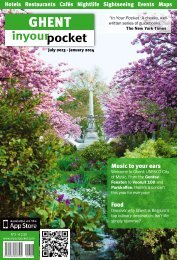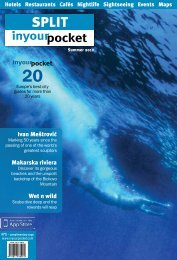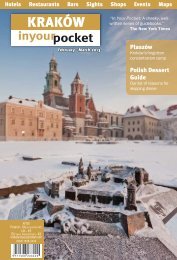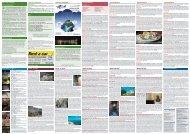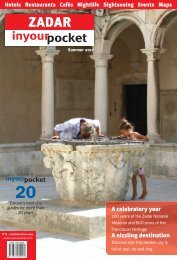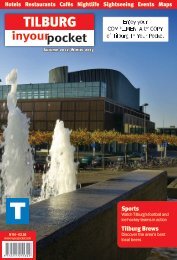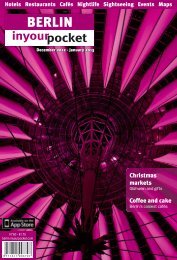7kh 7ul flw\ v prvw dxwkhqwlf 7h[ 0h[ uhvwdxudqw ... - In Your Pocket
7kh 7ul flw\ v prvw dxwkhqwlf 7h[ 0h[ uhvwdxudqw ... - In Your Pocket
7kh 7ul flw\ v prvw dxwkhqwlf 7h[ 0h[ uhvwdxudqw ... - In Your Pocket
You also want an ePaper? Increase the reach of your titles
YUMPU automatically turns print PDFs into web optimized ePapers that Google loves.
122 GDYNIA SIGHTSEEING<br />
Almost everything to see in Gdynia has a salty seaside<br />
theme. Lacking Gdańsk’s historic sites and the charm of<br />
Sopot, the city does at least provide one or two quirky<br />
things to see, as well as an absolutely stonking new<br />
museum dedicated to the city.<br />
Churches<br />
Church of St. Michael the Archangel (Kościół<br />
Św. Michała Archanioła) ul. Arciszewskich 2<br />
(Oksywie), tel. (+48) 58 665 00 63, www.parafia.<br />
oksy.net.pl. Originally built by nuns of the Norbertine<br />
Order in 1224, this church is now part of museum dedicated<br />
to Polish sailors and seafarers. On the northern wall<br />
is a plaque engraved with the names of Polish ships that<br />
sank during World War II. Also commemorated are Polish<br />
naval officers executed by the communists in 1952. The<br />
neighbouring graveyard is the resting place of Kashubian<br />
activist Antoni Abraham. Find it on the very northern tip of<br />
Gdynia, past the ferry harbour. Q Open during mass only<br />
and by prior arrangement.<br />
Church of the Sacred Heart of Jesus (Kościół<br />
Najświętszego Serca Pana Jezusa) N-1, ul.<br />
Armii Krajowej 46, tel. (+48) 58 661 51 92, www.<br />
nspjgdynia.pl. Built between 1957 and 1966, this at first<br />
glance rather ugly-looking church on closer inspection<br />
reveals a story and a beauty that encapsulates so much<br />
of the modern Polish religious psyche. A drab concrete<br />
exterior betrays a marvel of treats inside, among them<br />
Gdańsk artist Bogusław Marszal’s extraordinary and<br />
colourful mosaics from 1974, including astonishingly large<br />
renditions of The Last Supper, The Holy Spirit and The Ten<br />
Commandments. Also of interest is the organ, as big as the<br />
one in Oliwa Cathedral and the Shipyard Workers’ Chapel,<br />
allegedly the only one in Poland, and dedicated to the events<br />
of December 1970 when the Militia opened fire and killed<br />
18 of Gdynia’s shipyard workers as they made their way<br />
to work. Of particular interest inside is a blood-stained<br />
flag, used to carry the body of the 18-year-old shipworker<br />
Janek Wiśniewski (real name Zbigniew Godlewski) through<br />
the city’s streets. The name Janek Wiśniewski is the Polish<br />
equivalent of John Smith, and is the title of a famous<br />
ballad of the same name, whose author didn’t know the<br />
young man’s real name. QOpen 06:00 - 19:00. No visiting<br />
during mass please.<br />
St. Mary’s Church N-1, ul. Armii Krajowej 26 (entrance<br />
from ul. Świętojańska), tel. (+48) 58 620 05<br />
52, www.nmp-gdynia.pl. Centrally located St. Mary’s was<br />
completed in 1924, when local residents helped to furnish the<br />
new church via donations. The main alter, which was built by<br />
a local carpenter, features a large gold three-masted ship to<br />
reflect Gdynia’s seafaring history. Today the small church is<br />
flanked by a bookstore (loaded with Pope John Paul II goods),<br />
a newer and more modern church and a primary school, which<br />
makes for a lively spot crawling with uniformed students and<br />
nuns. The bells at noontime are especially vibrant and can<br />
be heard as far away as the beach. Q Open 06:00 - 18:00.<br />
From July open 06:00 - 18:00, Sun 06:00 - 20:00.<br />
Tour guide<br />
Agnieszka Syroka, tel. (+48) 502 55 45 84, www.<br />
tourguidegdansk.com. Tours offered in English by a<br />
certified local tour guide. Tours are prepared to suit the<br />
client and should be booked in advance. QOpen 09:00<br />
- 22:00. Prices are negotiable.<br />
Monuments<br />
Joseph Conrad Monument O-1, Al. Jana Pawła II 1.<br />
The work of Danuta and Zdzisław Koseda and Wawrzyniec<br />
Samp, and unveiled in 1976, Gdynia’s tribute to Poland’s<br />
most famous sea-faring author (born Teodor Józef Konrad<br />
Korzeniowski, 1857 - 1924), who hailed from Białystok and<br />
who as far as anyone can tell had no connections with Gdynia,<br />
sits splendidly opposite the city’s Oceanographic Museum<br />
adding a touch of class to the pleasant concrete spit of land<br />
on which it’s placed. The delightfully stylised monument is<br />
allegedly the only one in the world dedicated to the great man.<br />
Monument to the Victims of December 1970<br />
(Pomnik Ofiar Grudnia 1970) N-2, Al. Piłsudskiego.<br />
Designed by Ryszard Semka and unveiled on December 17,<br />
1993, the Monument to the Victims of December 1970 is<br />
an impressive 25 metre cross commemorating 18 year old<br />
Zbyszek Godlewski, killed during the anti-government shipyard<br />
protests which took place on the streets of Gdynia in that year.<br />
Monument to the Victims of December 1970<br />
(Pomnik Ofiar Grudnia 1970) Al. Solidarności. One<br />
more monument commemorating the death of 18 year old<br />
protestor Zbyszek Godlewski, this one unveiled on December<br />
17, 1980 - the tenth anniversary of Godlewski’s death.<br />
Museums<br />
City of Gdynia Museum (Muzeum Miasta Gdyni)<br />
O-2, ul. Zawiszy Czarnego 1, tel. (+48) 58 662 09 10,<br />
www.muzeumgdynia.pl. Impressively modern and well<br />
run, the City of Gdynia museum takes visitors through the<br />
chronological history of the town beginning with its origins<br />
as a fishing village through its evolution as an important<br />
international port during the inter-war years. Displays of<br />
fishing shanties and vintage diving suits bring these different<br />
periods to life, and photographs of the growing port and the<br />
ships that called it home emphasize the city’s maritime history.<br />
Keepsakes from defunct hotels and old vessels mingle<br />
with faded documents and countless Navy uniforms, which<br />
can keep visitors wandering for ages. The revolving temporary<br />
exhibits are equally as intriguing, including a recent<br />
display that recounted the career of popular Polish filmmaker<br />
Krzysztof Kieślowski. Around the back of the museum you’ll<br />
find retired vessels that will become part of the city’s Naval<br />
Museum when it opens. QOpen 10:00 - 17:00. Closed Mon.<br />
Admision 7/4zł, Fri free.<br />
Dar Pomorza O-1, Al. Jana Pawła II (Nabrzeże Pomorskie),<br />
tel. (+48) 58 620 23 71, www.cmm.pl. Reopening<br />
on January 17, this three-masted Polish training ship has<br />
visited 383 ports and travelled more than 800,000km in her<br />
time at sea. Constructed in 1909 in Hamburg to train cadets<br />
for the German navy, she was after World War I given to the<br />
French who, in turn, gave her to an Englishman in French service.<br />
The ship was subsequently bought by the Pomeranian<br />
National Fleet. Since 1972 she has taken part in numerous<br />
sailing competitions, winning the Cutty Sark Trophy in 1980.<br />
A year later she was bestowed the highest Polish State decoration:<br />
the order of Polonia Restituta. Q Open 10:00 - 16:00.<br />
Closed Mon. From July open 09:00 - 18:00. Last entrance<br />
30 minutes before closing. Admission 8/4zł. Y<br />
Domek Abrahama (Abraham’s House) N-1, ul.<br />
Starowiejska 30, www.muzeumgdynia.pl. Possibly the<br />
smallest museum you’ll have the chance to visit, your time<br />
spent here is liable to extend to all of fifteen minutes. One<br />
of the oldest cottages in Gdynia, this served as home for the<br />
Kashubian activist Antoni Abraham from 1920 up until his<br />
Gdynia <strong>In</strong> <strong>Your</strong> <strong>Pocket</strong> gdynia.inyourpocket.com<br />
death in 1923. Fighting for the reincorporation of Pomerania<br />
into the Polish state, a few details of his life have been left<br />
in this reasonably fascinating diorama. Among the curiosities<br />
are prosthetic limbs, a bed pan under the bed, sewing<br />
machines and clunky bits of farming equipment. QOpen<br />
10:00 - 16:00. Closed Mon, Sun. Admission 2/1zł. Guided<br />
tours by prior arrangement 10zł.<br />
Gdynia Aquarium (Akwarium Gdyńskie) O-1, Al.<br />
Jana Pawła II 1, tel. (+48) 58 732 66 01, www.akwarium.<br />
gdynia.pl. A perfect post-sunburn hideout or rainy day escape,<br />
the Gdynia Aquarium is stuffed with over 1,500 animals<br />
spread over 68 different exhibits, and pint-sized guests will<br />
delight in seeing every one. New features like the dwarf crocodile<br />
- which often can’t be bothered to look anything less than<br />
dead - keep the exhibits fresh, and children will beg to adopt<br />
a frisky Chinese softshell turtle of their own. Exhibits cover<br />
marine life from across the globe, like Australian spotted jellyfish<br />
and Amazon-dwelling giant arapaima, but also delve into<br />
the evolution of submersible technology through the decades.<br />
The third floor Baltic Room is devoted to understanding the sea<br />
literally right outside the Aquarium’s windows, but a history of<br />
the sea will take a backseat to the giant 44 kg cod - the largest<br />
creature ever caught in the Baltic - dangling over your head.<br />
English placards are spotty at best, so parents be prepared<br />
to make up origins for the colorful tomato clownfish and the<br />
pancake-like moonfish. A large open-air deck offers the idea<br />
place to take in aquatic views and have a snack. Q Open<br />
09:00 - 19:00. From June open 09:00 - 20:00. Last entrance<br />
30 minutes before closing. Admission 24/16zł.<br />
Motor Museum (Muzeum Motoryzacji) ul. Żwirowa<br />
2c (Chylonia), tel. (+48) 58 663 87 40, www.gdynskiemuzeum-motoryzacji.pl.<br />
A real labour of love this place.<br />
The owner first started collecting old motor bikes when he<br />
was 8, saving the money he should have been spending on<br />
his school lunch to pay for them. Since then his passion has<br />
not waned and following his studies at mechanics school<br />
and with the help of the local government and some private<br />
sponsors he has now managed to put this collection together<br />
which he now displays to the public. On show a collection of<br />
vintage motor-bikes, sidecars, cars and a classic Mercedes-<br />
Benz. QOpen 09:00 - 17:00. Closed Sun. Admission 7/3zł.<br />
Naval Museum (Muzeum Marynarki Wojennej)<br />
O-2, ul. Zawiszy Czarnego 1b, tel. (+48) 58 626 39 84,<br />
www.muzeummw.pl. The large front doors of the modern<br />
building on the seafront that promises a wealth of fascinating<br />
sights and sensations for visitors continues to remain locked<br />
and despite earlier assurances that it would open shortly, and<br />
the latest gossip suggests entrance will be no earlier than<br />
summer 2012. Even the jumbled collection of arms, cannons,<br />
medieval gun carriages, planes, helicopters and submarines<br />
from early Slavic times to WWII in the museum’s back garden<br />
cannot be visited until April or May. Of note (when they reopen)<br />
are 18th century cannons, shells from the Schleswig-Holstein<br />
(the ship that kicked off WWII), and a canon recovered from a<br />
German U-boat sunk in Gdynia harbour in 1945. We’ll be back<br />
to see how this long awaited addition to Gdynia’s sightseeing<br />
options stacks up before the summer issue. QOpen 10:00 -<br />
17:00, Mon 12:00 - 18:00. Last entrance 30 minutes before<br />
closing. Admission 4/2zł. Mon free.<br />
Tourist information<br />
Tourist <strong>In</strong>formation Center N-1, ul. 10 Lutego 24,<br />
tel. (+48) 58 622 37 66, www.gdyniaturystyczna.pl.<br />
QOpen 09:00 - 18:00, Sat, Sun 09:00 - 16:00.<br />
gdynia.inyourpocket.com<br />
GDYNIA SIGHTSEEING<br />
Błyskawica<br />
Błyskawica O-1, Skwer<br />
Kościuszki 12, tel. (+48)<br />
58 626 36 58, www.navy.<br />
mw.mil.pl. With the Treaty of<br />
Versailles a done deal Poland<br />
found itself a nation state once<br />
more, granted access to the<br />
sea via what was to become<br />
the infamous ‘Polish Corridor’.<br />
For the first time in a century<br />
Poland had coastline and her<br />
own waters, the only thing<br />
missing was a navy to guard it. Polish defensive bods<br />
designed a new fast attack class of destroyer, and the<br />
tender was won by the JS White firm based in Cowes on<br />
the Isle of Wight. Their s.p was to build two such destroyers,<br />
the Błyskawica (Lightning), and a sister ship, ORP<br />
Grom (Thunder). A fledgling navy it might have been, but<br />
this pair were no laughing matter. Measuring 114 metres<br />
in length, weighing 2,782 tonnes and powered by turbines<br />
rated at 54,00<strong>0h</strong>p, these were to become the fastest<br />
destroyers in the world when launched in 1936. Armed<br />
to the teeth and boasting a top speed of 39 knots the<br />
two were to serve a dual purpose: both as fast surface<br />
attack craft and submarine chasers.<br />
Both boats were spirited to England on the eve of<br />
war as part of the Peking Plan, and from there on the<br />
Polish craft came under the command of the British<br />
Royal Navy. Based in Cowes the Błyskawica saw action<br />
several times, including in the Mediterranean,<br />
Normandy and as an Atlantic convoy escort. However,<br />
her finest moment was to come in Cowes. Captained<br />
by Wojciech Francki, it was on the night of the 4th May<br />
1942 that the British town came under attack from up<br />
to 160 Luftwaffe bombers. Anticipating an attack Capt.<br />
Francki had sneakily ensured the Błyskawica was wellarmed,<br />
despite a ruling stating the vessel should have<br />
been decommissioned while in port. <strong>In</strong> a further breach<br />
of regulations Francki ordered his crew to fight off the<br />
waves of bombers, and what followed was a ferocious<br />
battle between sea and air - such was the rate the boats<br />
guns were firing the crew were compelled to continually<br />
douse them with seawater in a bid to cool them.<br />
The heroic defence and the smokescreen that was lit<br />
was enough to thwart the Luftwaffe, and the captain<br />
and crew were hailed as the ‘saviours of Cowes’. Less<br />
forthcoming in their recognition were the pedants in<br />
the British Admiralty; conscious of condoning a blatant<br />
violation of the rules they sent a tight-lipped dispatch<br />
commending the good work done by Francki.<br />
At the end of the war the Błyskawica returned to Poland,<br />
though without its captain and many of its crew. Francki<br />
chose a new life in Australia, away from the suspicions<br />
and hostility of the new communist government, and it<br />
was a lead followed by many of his ratings. <strong>In</strong> 2004 the<br />
actions of the Błyskawica were formally acknowledged,<br />
and a plaque unveiled in the port of Cowes by Francki’s<br />
daughter. The ship itself was retired from service in<br />
1969, and has since served as a museum ship held in<br />
the sort of regard the Brits reserve for the HMS Victory.<br />
It’s the only boat to be awarded Poland’s highest military<br />
decoration, the Gold Cross of the Virtuti Militari Order,<br />
and other points of interest include a three barrelled<br />
torpedo launcher, a torpedo cross section, scale models,<br />
weapons and uniforms.QOpen 10:00 - 12:30, 14:00 -<br />
16:30. Closed Mon. Admission 8/4 zł.<br />
May - July 2012<br />
123



